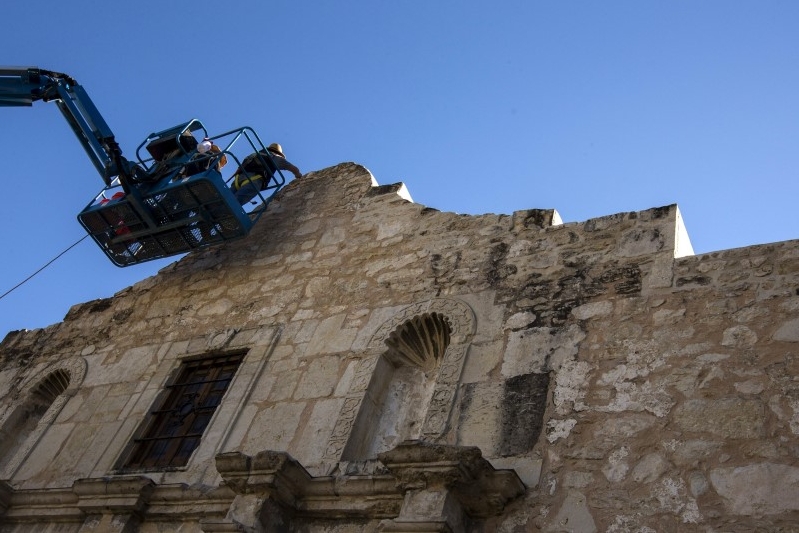
The man who long-headed San Antonio's Chamber of Commerce has grown tired of the reaction he receives from the visitors he takes to the Alamo, the highly recognizable monument to Texas independence and the state' most-visited tourist site.
"Underwhelmed," is how Joe Krier, also a city councilman, sums up many of the reactions.
The clamor of city traffic, the modern hotels and office towers rising up around the surprisingly small building have diminished the stature of the white stone-walled structure with its distinctive curved facade. An often-used derision is that it looks like a tourist trap.
The state of Texas has also heard the complaints and the legislature has set aside $32 million to transform the Alamo and the plaza in front of it for the first time in more than a century. It is planning a facelift that will preserve its history and restore dignity to the square where a momentous event in state history unfolded.
"The problem is, it doesn't look like John Wayne's movie set," said Richard Bruce Winders, the long-time official Alamo historian, referring to the iconic 1960 film where Wayne played Alamo defender and famed frontiersman Davy Crockett.
The structure began life as a Spanish colonial mission in the mid 1700s.
In the 1836 battle between Texian and Mexican forces, the Alamo's vastly outnumbered defenders were routed by Mexican forces in a 13-day siege. But the battle became a rallying point for the Texas forces, who defeated the Mexican Army a few weeks later.
For most the 20th century, the Daughters of the Republic of Texas, an underfunded heritage organization, has managed the building ever since it prevented a portion of the grounds from being sold to a hotel developer in 1905.
DON'T MESS WITH PHIL COLLINS
But over the past three years, the state wrestled control from the group, and has looked to a brighter future thanks in part to musician Phil Collins, who fell in love with the Alamo watching the Davy Crockett TV show in England in the 1950s and collected pieces of its history.
Last year Collins, who has earned the status of honorary Texan for his largess, donated the largest privately held collection of Alamo artifacts to the state, on the condition that a world class museum be built to house it.
An Alamo Endowment, headed by some of the state's best fundraisers, has vowed to raise as much as $300 million to help with the project, on top of the money set aside by lawmakers.
The United Nations also weighed in earlier this year by declaring the Alamo and the four other San Antonio Spanish missions to be World Heritage Sites, the first in Texas.
"All of the pieces have finally come together," said Alamo Director Becky Dinnin.
"We finally have the ability to do things that have to be done to better tell this story."
WHICH HISTORY?
But the questions is, which history should be told?
Some preservationists hope to restore the Alamo and its plaza to the way they appeared on March 6, 1836, when Mexican forces stormed over the walls before dawn and the famous Battle of the Alamo took place.
"Then you would have to remove the parapet," Winders said, adding the famous rounded facade did not exist during the battle, and was added by the U.S. Army when it took over the abandoned building as a supply depot after Texas joined the union in 1845.
Dinnin said there are so many layers of history from the Spanish colonial time, the battle, and the industrial build up of San Antonio into the seventh most populous U.S. city.
"It's always a balance," said Kim Barker, Project Manager for Historic Resources for the Texas General Land Office.
As to the bustling 21st century community with the hotels and office towers and tourist-oriented businesses crowding in on the historic shrine, Barker says that is also part of the ongoing story of the Alamo.
The state recently purchased several buildings in front of the Alamo as part of the long-term plan to re-invent the plaza, and there is talk of demolishing them to give the Alamo more space.
But Winders points out some of those buildings were originally developed by Samuel Maverick, one of the founders of Texas whose name coined the term "Maverick," which originally referred to his unbranded cattle herd.
"What the Spanish intended was that the Mission be the seed of a community. So it was a success," said Barker.
"We need to respect that, at the end of the day, it did its job. It is in the middle of a very large city. And that is also part of the story of the Alamo."
(Additional writing by Jon Herskovitz; Editing by Alan Crosby)







